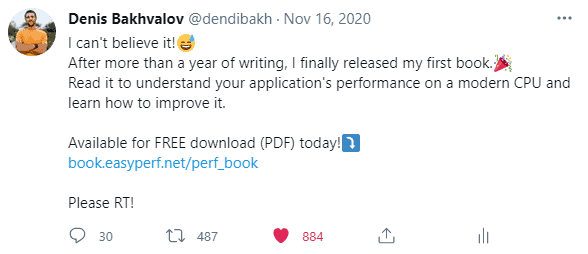Are you preparing the future product that will take over the world, and you haven’t yet decided on the pricing scheme? Then consider making it free by default!
You’re probably thinking: “Nonsense, absurd! Why would I ever want to do that?” Well, maybe this article will give you some perspectives that you haven’t thought about before.
The first free product I created was a free book released in November 2020 and has been very successful: more than 7000 readers so far. For a book in a very narrow niche, it is quite an achievement. I was able to grow my mailing list by more than 10x (5000+ people so far) and still was able to earn good money by selling the paperback version on Amazon.
I recently launched my online course with the same monetization scheme and I expect it to be as successful as the first one.
In this post, I will share my experience with you—mentioning both pros and cons—and I will show you how offering donation-based products can have significant long-term benefits.
My Experience With Creating Free Products
Frankly, the idea of making my products free didn’t come instantly to me. It was shaping in my mind for months. Like most, I wanted to go with the traditional scheme, i.e., offering my product in exchange for a fixed price. Only after I defined my actual goals and what I wanted to achieve with launching my product was I able to properly evaluate each option.
What I truly wanted was not to earn money and walk away. My primary goal was to build a personal brand, build a name for myself, and get noticed, which at that time was much more important for me than to earn a few thousand dollars, which could easily dissolve if you live in California.
Let me reiterate that it’s crucial that you define your goals clearly! If you do, the choice will be much easier to make. I aimed for long-term benefits and acted accordingly. The short-term goal here would be just to earn some quick money and go for another gig without really building relationships with the customers. If you’re still with me, I prepared a list of pros and cons for going with a free product. Let’s start with the positive sides first.
The Pros to Offering a Free Product
A free product reaches more people since, well, it’s a no-brainer. It’s free, right? People with FOMO will especially like it. More folks will get to know you and your good stuff. With my book, my primary goal was to maximize the number of readers and build relationships with them. According to various resources, the average technical book sells well below 1000 copies in its lifetime. I was clearly able to outperform the average.
If you think that everyone will buy your stuff because it is so awesome, I might disappoint you. Even the greatest products can go unnoticed if marketed poorly. Don’t expect a lot of sales from the start if you haven’t yet built a name for yourself. Targeted ads may help drive sales, but they won’t build long-term relationships with your audience.
I believe that you need to give a lot of value first to the people that later will become your customers. You’re earning your credit so that next time folks will be eager to buy your product. Every new product will sell much much easier than the one before it. I collected almost 5,000 emails from people interested in what I’m doing. Building an audience is key! You sacrifice some amount of money to reach more people and build your brand.
It’s easier to engage others to contribute to a free product. This was actually THE most important thing for me. When people know that the product is going to be free, they are willing to contribute to it since they know their work will not be silently utilized to make money. No strings attached. They follow your idea and want to be a part of it.
This fact allowed me to leverage the work of many great folks. I had 45 reviewers for my book and five other persons that made a significant contribution to my book. I doubt publishers bring that much workforce in. Bringing folks from different backgrounds and different industries makes a better quality product since it goes through the eyes of hundreds of people.
You release yourself from having angry customers. No more hateful emails from folks complaining that the product didn’t meet their expectations. The product is free, right? You don’t like it? That’s OK. But no one will send you messages requesting their money back since they didn’t pay anything. In that sense, your karma is protected.
All of the above surely sounds great, but let’s face it: The world is dominated by traditional paid products. The most frequent objection I hear against making your free products is this: “Denis if you give away everything for free, how will you make money?”
“Pay What You Want” Pricing

When you allow your customers to choose the price tag for your work, you essentially let them pay according to the value they get out of it. The “Pay What You Want” scheme reflects the value it brings to the people.
For example, one of the donations for my free book was $100. Imagine someone paying $100 for the book that’s available for a free download! It must be very useful for this person, right? By putting a fixed $30 price tag, you limit the grace of those people who really enjoyed your work.
In addition, a flexible price makes the product more accessible for poorer countries. People from California can pay $30 for a book, no problem, but in other countries, it may not be so easy.
Unexpected Opportunities
Second, I think what people are missing here is the fact that you can convert your social capital into actual money, but the opposite is not always possible. It’s like in a story with a goose delivering golden eggs: The longer you don't kill it, the better the payday will be. At some point, you can decide: ”Ok, I’ve built enough reputation, I can now use it to make some money”.
There are many ways to earn money on your personal brand. You can do it by offering a traditional product with a price tag. Now that you have loyal customers, selling would be much easier to do. Further, you can make money from advertising something on your platform or participating in affiliate programs. Finally, you can accept a better-paying job offer since you have a good reputation.
But the real beauty of it is in unexpected opportunities coming your way. You may suddenly find packs of HR folks knocking on your LinkedIn account, invitations to podcasts, and other collaborations. You never know all the amazing opportunities the world may bring to you. So be patient and trust the process.
In his popular book “The Millionaire Fastlane,” MJ DeMarco wrote: “Impact millions, and you will make millions.” So, I think what you really should focus on is how to bring as much value to as many people as you can. Money will follow.
But OK, you definitely want to hear what are the other drawbacks of free products. Without it, we wouldn’t have a full picture.
The Cons to Offering a Free Product
Here’s why you might not want to offer your product for free.
Some people think that if a product is free, it must be a low-quality one. True, and it’s hard to counter. You really have to make a good product; there are no workarounds to it. Do your job right and have word of mouth do the rest. Also, you can differentiate your offer by providing trial and premium versions of your product. That’s how many companies market their products.
“Pay What You Want” may not work for physical products or products with a high price tag. Indeed, it won’t be profitable to sell a car, the price of which goes from $1000 to $20000, you will incur huge losses. There were experiments in the food sector that didn’t work out as well. But in such areas as info products and software, with the prices below $100, it can make perfect sense.
How To Make a Donation-Based Product More Effective
Don’t forget to ask for a payment or a donation! If you don’t ask, you certainly won’t get one. You should also make it easy for users to donate. Adding a Paypal button on your blog or sales page is one way, but also you can refer people to your Patreon and Github Sponsors page. Also, crypto donations are getting traction.
Ask people to pay after they consume your product. There is no way for your customers to know if the thing is good or not before they try it, right? But once they have, they can really assess its value. And when people find it useful, they will be much more willing to donate.
Say where the money will go. It could be covering your costs or charity; both are good justifications. People are much more likely to pay if they know how their money will be spent. Be transparent as much as possible.
Show that you have a big goal. People with ambitions and vision are like magnets—everybody wants to follow them. Remember Forrest Gump running? Just a run, nothing fancy, right? Still, everybody thought that he was on a mission pursuing something big. So people started joining him because they wanted to be a part of a bigger idea. The same here, you need to show that you’re trying to achieve something.
An Overlooked Idea With Potential

By making your product free by default, you can reach more people and build your personal brand faster. Also, it will be much easier for you to engage others to contribute to your project. Moreover, you don’t have to worry about angry paying customers.
At the same time, there are certainly challenges involved: You’ll need to make sure your product is of high quality, as free often connotes mediocrity. Moreover, certain products might not be well suited to such a model, as they might lead to losses.
Generally, however, there can be unexpected opportunities in offering a free product. Merely the fact that you can reach many people and see all kinds of doors opening is definitely worth the effort. Give it a try!

